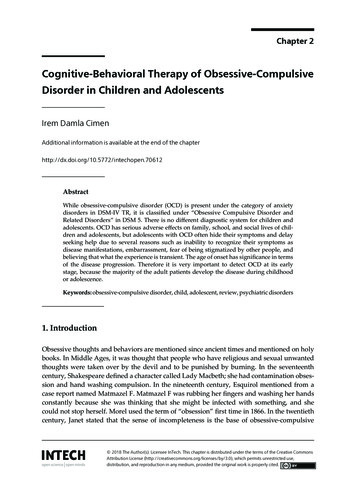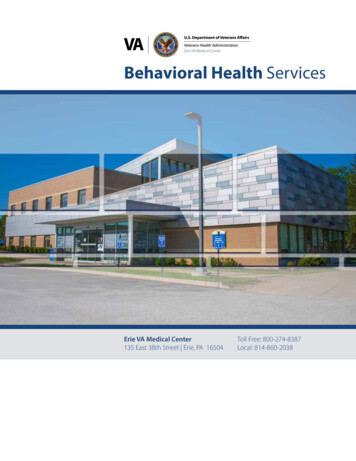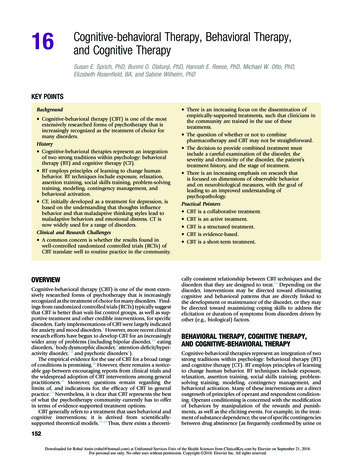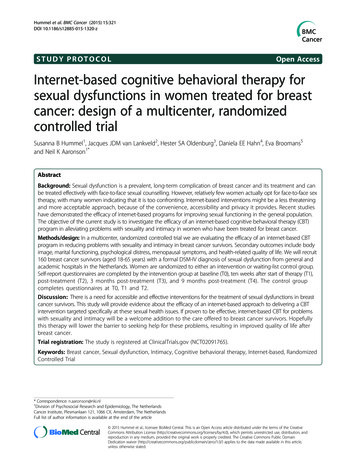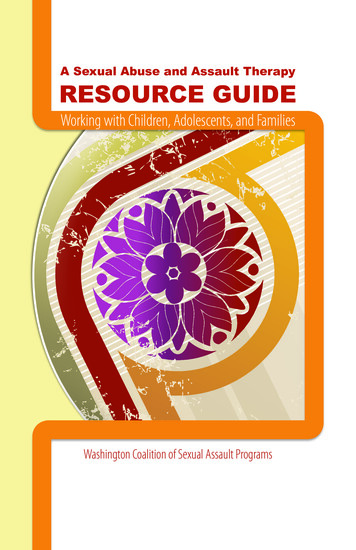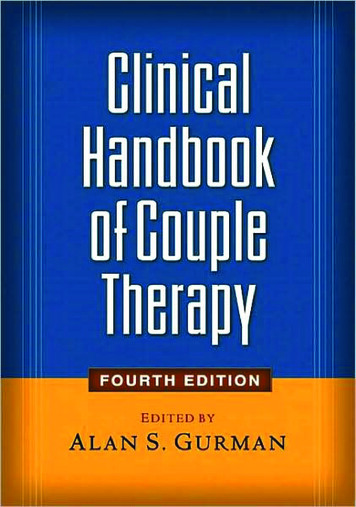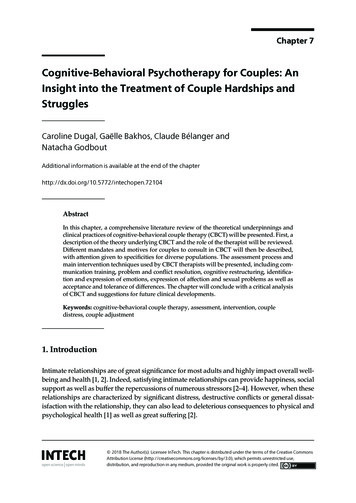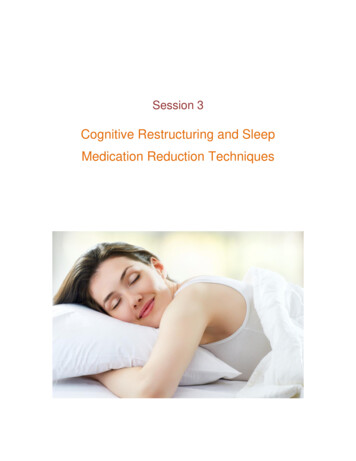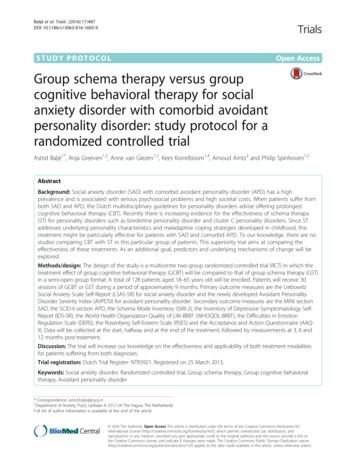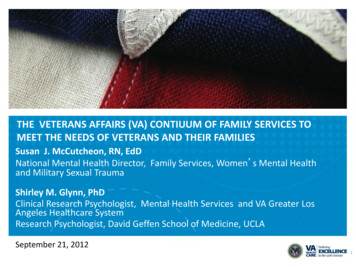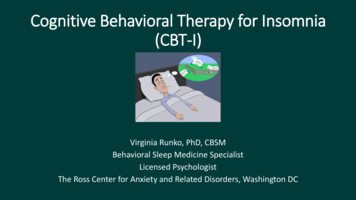
Transcription
Cognitive Behavioral Therapy for Insomnia(CBT-I)Virginia Runko, PhD, CBSMBehavioral Sleep Medicine SpecialistLicensed PsychologistThe Ross Center for Anxiety and Related Disorders, Washington DC
Workshop Learning Objectives Recognize for whom CBT-I is and is not appropriate Execute the various components of CBT-I, includingsleep restriction and stimulus control Describe common resistances to CBT-I and strategiesfor overcoming them
DisclosuresI have nothing to disclose.
Outline2-2:15pm:Insomnia criteria & determining if CBT-I is indicated2:15-2:45pm:CBT-I session-by-session2:45-3:15pm:Cases from presenter & attendees3:15-3:30pm:Resistances3:30-4pm:Group role-playing
Outline2-2:15pm:Insomnia criteria & determining if CBT-I is indicated2:15-2:45pm:CBT-I session-by-session2:45-3:15pm:Cases from presenter & attendees3:15-3:30pm:Resistances3:30-4pm:Group role-playing
Defining InsomniaDiagnosis of insomnia made by self-reportNo overnight sleep study required to diagnose insomniaHowever, sleep studies might be conducted to rule-out othersleep disorders that might cause or coexist with the insomniaSchutte-Rodin et al. Clinical guideline for the evaluation and management of chronic insomnia in adults. J of Clin Sleep Med 2008, 4(5), 487-504.
Defining InsomniaDSM-5 Definition of Insomnia Disorder Complaint of sleep quantity or quality associated with problems fallingasleep, staying asleep, and/or early morning awakenings The sleep problem causes distress and/or some sort of problem at work,with others, etc. The sleep problem occurs at least 3 nights/week and has been going onfor at least 3 months The sleep problem occurs despite adequate opportunity for sleep The insomnia is not better explained by another sleep disorder, is notcaused by the effects of a substance, and is not adequately explained bycoexisting mental disorders or medical conditions NOTE: insomnia is diagnosed whether it occurs as an independent condition or iscomorbid with another mental disorder, medical condition, or another sleepdisorder; insomnia is not diagnosed when the insomnia is not severe enough towarrant independent clinical attention
Why Bother Screening for Other Sleep Disorders? Another sleep disorder might cause/worseninsomnia symptoms Insomnia might worsen another sleep disorder For differential diagnosis (e.g., sleep onset insomniamight actually be delayed sleep phase syndrome) The “standard” approach to CBT-I is contraindicatedfor those with certain untreated sleep disordersAmerican Academy of Sleep Medicine. International classification of sleep disorders, 3rd ed.Spielman et al. Sleep Restriction Therapy in Perlis et al. Behavioral Treatments for Sleep Disorders. 2011, 21-30.
Other Sleep Disorders & Insomnia Symptoms Sleep Apnea Problems with staying asleep can be associated with sleep apnea Part of CBT-I – sleep restriction – is contraindicated in patients with untreated sleepapnea Restless Legs Syndrome Problems falling and staying asleep are associated with RLS Periodic Limb Movement Disorder Problems falling asleep, staying asleep, or unrefreshing sleep attributable to the PLMSis required for a diagnosis of PLMD Narcolepsy Sleep disruption with frequent awakenings may be present
Other Sleep Disorders & Insomnia Symptoms Isolated Symptoms & Normal Variants (NOT insomnia) Excessive Time in Bed Short Sleeper Insufficient Sleep Syndrome Daytime sleepiness caused by too little sleep due to reduced time in bed Circadian Rhythm Disorders
Delayed & Advanced Sleep Phases12pm4pm8pm12am4am6pm to 2am8amadvanced sleep phase10pm to 6amdelayed sleep phasetypical sleep phase2am to 10am* problems falling asleep can be due to a delayed sleep phase* problems waking up too early can be due to an advanced sleep phase12pm
Spielman’s 3 Factor Model of InsomniaSpielman et al. A behavioral perspective on insomnia treatment. Psychiatr Clin of North Am 1987, 10(4), 541-553.
Classical Conditioning
Conditioned Arousal Overtime
Spielman’s 3 Factor Model of InsomniaSpielman et al. A behavioral perspective on insomnia treatment. Psychiatr Clin of North Am 1987, 10(4), 541-553.
Treatments for Insomnia Sleep aids Addressing precipitating factors Address perpetuating factors
Treatments for InsomniaAddressing precipitating factors Medical/psychiatric management Stress management Improving sleep hygiene
Treatments for InsomniaAddressing precipitating perpetuating factors Cognitive Behavioral Therapy forInsomnia
CBT-I is Effective Scientific reviews and meta-analyses show that CBT-I is effective (Irwinet al., 2006, Health Psychol, 25(1), 3-14; Morin et al., 2006, Sleep, 29(11), 1398-414; Murtagh & Greenwood, 1995, J Consult ClinPsychol, 63(1), 79-89) CBT-I is recognized by the NIH Consensus and State-of-the-ScienceStatement as a first-line treatment for insomnia as it was found tobe as effective as medication for brief treatment and likely moredurable over time (NIH Consens and State Sci Statements, 2005, 22(2), 1-30) CBT-I is recommended as standard, first-line treatment for insomniaper published clinical guidelines by the Chronic Insomnia Task Forceof the American Academy of Sleep Medicine (Schutte-Rodin et al., 2008, J of Clin SleepMed, 4(5), 487-504).
Is CBT-I Appropriate?Sleep Assessment Is this insomnia or something else (e.g., insufficient sleep syndrome)? Even if comorbid conditions present (e.g., depression, pain), CBT-I can be beneficial* Even if the patient is on sleep aids or wants to start taking sleep aids, this can be donein combination with CBT-IPatient Characteristics Is the patient motivated to try CBT-I? Do they just want a pill?Does the patient have sufficient intellect to benefit from CBT-I?CBT-I is intended for adult patientsA major component of CBT-I (sleep restriction) is contraindicated for those with bipolardisorder, untreated sleep apnea, parasomnias, and seizure disorder (Perlis et al. BehavioralTreatments for Sleep Disorders. 2011), so CBT-I should be modified in these cases A sleep study should be conducted in cases of suspected sleep apnea before sleep restrictionstarted* McCrae & Lichstein. Secondary insomnia: Diagnostic challenges and intervention opportunities. Sleep Med Rev 2001, 5(1), 47-61.
Outline2-2:15pm:Insomnia criteria & determining if CBT-I is indicated2:15-2:45pm:CBT-I session-by-session2:45-3:15pm:Cases from presenter & attendees3:15-3:30pm:Resistances3:30-4pm:Group role-playing
CBT-I ProtocolIntake Session: Assessment, start sleep diariesTx Session #1: Review sleep diaries, educate about sleep drive & circadian rhythm,present 3P model, start stimulus control & sleep restrictionTx Session #2: Review, titrate, sleep hygieneTx Session #3: Review, titrate, relaxation trainingTx Session #4: Review, titrate, cognitive therapy ITx Session #5: Review, titrate, cognitive therapy IITx Session #6: Review, titrate, insomnia relapse preventionCBT-I is typically 4 to 8 weekly treatment sessions (Perlis et al. Cognitive Behavioral Treatment of Insomnia: ASession-by-Session Guide. 2005)
CBT-I ProtocolIntake Session: Assessment, start sleep diariesTx Session #1: Review sleep diaries, educate about sleep drive & circadianrhythm, present 3P model, start stimulus control & sleep restrictionTx Session #2: Review, titrate, sleep hygieneTx Session #3: Review, titrate, relaxation trainingTx Session #4: Review, titrate, cognitive therapy ITx Session #5: Review, titrate, cognitive therapy IITx Session #6: Review, titrate, insomnia relapse prevention
Intake SessionAssessment should include: History of insomnia symptoms and past treatments Present sleep complaints Other sleep disorders, any past sleep studies General sleep schedule (remember weekend vs. weekday, naps) Sleep hygiene factors (environment, caffeine intake, exercise, etc.) Sleep-related anxiety/stress/frustration, evidence of conditioned arousal Psychiatric & medical history Medications
Sleep Logs
CBT-I ProtocolIntake Session: Assessment, start sleep diariesTx Session #1: Review sleep diaries, educate about sleep drive & circadianrhythm, present 3P model, start stimulus control & sleep restrictionTx Session #2: Review, titrate, sleep hygieneTx Session #3: Review, titrate, relaxation trainingTx Session #4: Review, titrate, cognitive therapy ITx Session #5: Review, titrate, cognitive therapy IITx Session #6: Review, titrate, insomnia relapse prevention
Sleep Logs
Sleep Logs
Sleep Logs
Sleep Logs
Education Important! First, it’s very important to provide the patient some education aboutsleep to demonstrate the rationale behind CBT-I strategies since somerecommendations will seem counterintuitive, might make sleepworse before it gets better This education at a minimum should include background about: Homeostatic sleep drive & circadian rhythm 3 P Factor ModelPerlis, Aloia, & Kuhn (eds.). Behavioral Treatments for Sleep Disorders. 2011.
Sleep Regulation: Internal MechanismsBorbély, AA. A two process model of sleep regulation. Hum. Neurobiol. 1982, 1 (3): 195–204.
3 P Model & CBT-ICBT-I primarilytargetsperpetuatingfactors (e.g.,napping,oversleeping,spending toomuch time in n et al. A behavioral perspective on insomnia treatment. Psychiatr Clin of North Am 1987, 10(4), 541-553.
Stimulus Control to Conditioned Arousal Overtime
Classical Conditioning Lying awake in bed night after night essentially “pairs” thebed/bedroom with wakefulness and possibly also anxiety andfrustration This pairing, over time, can cause the bed/bedroom toautomatically trigger feelings of wakefulness, anxiety, frustration “Conditioned arousal” Stimulus control attempts: (1) to break this pairing of bed withwake, and (2) to strengthen the pairing of bed with sleep and fallingasleep quickly ( and this will take time)Bootzin & Perlis. Stimulus Control Therapy in Perlis et al. Behavioral Treatments for Sleep Disorders. 2011, 21-30.
Stimulus Control Instructions1.Do not use your bed for anything except sleep; that is, do not read, watch TV, eat, orworry in bed. Sexual activity is the only exception to this rule. On such occasions, theinstructions are to be followed afterward when you intend to go to sleep.2.If you find yourself unable to fall asleep within about 15-20 minutes, get up and gointo another room. Since I do not want you to watch the clock, just estimate how longyou have been lying awake. Remember, the goal is to associate your bed with fallingasleep quickly! Return to bed intending to go to sleep only when you are very sleepy,or after a predetermined amount of time ( ).3.While out of bed during the night, you can engage in quiet, sedentary activities (e.g.,reading, TV viewing, etc. – but make sure content of such is not too engaging oractivating). Do not exercise, eat, smoke, or take warm showers or baths. Try not tofall asleep when not in bed.4.If you return to bed but still cannot fall asleep within 15-20 minutes, repeat step 2. Dothis as often as necessary throughout the night.Instructions slightly modified from Bootzin & Perlis. Stimulus Control Therapy in Perlis et al. Behavioral Treatments for Sleep Disorders. 2011, 21-30.
Sleep RestrictionWhite boxes:wakeDark boxes:sleepFigure from Perlis et al. Cognitive Behavioral Treatment of Insomnia: A Session-by-Session Guide. 2005
Sleep Logsprescribed TIB TST 15 minutes (but can use judgment for 0-30 mins)*min TIB of 4-5 hoursIn this example, prescribed TIB would be 4 hrs 45 mins for 1 weekSpielman et al. Sleep Restriction Therapy in Perlis et al. Behavioral Treatments for Sleep Disorders. 2011, 21-30.
Sleep Restriction Instructions1. Your bedtime is .2. Set your alarm and get up at the same time every morning, regardless ofhow much sleep you got during the night. Your wake time is.3. Do not nap during the day.** In cases where sleepiness might cause harm to self or others, go ahead andnap, go to bed earlier, sleep in, etc. In elderly, scheduling a nap might bebeneficial, but try to limit to 30 minutes (and track this!).
Is CBT-I Appropriate?Sleep Assessment Is this insomnia or something else (e.g., insufficient sleep syndrome)? Even if comorbid conditions present (e.g., depression, pain), CBT-I can be beneficial* Even if the patient is on sleep aids or wants to start taking sleep aids, this can be donein combination with CBT-IPatient Characteristics Is the patient motivated to try CBT-I? Do they just want a pill?Does the patient have sufficient intellect to benefit from CBT-I?CBT-I is intended for adult patientsA major component of CBT-I (sleep restriction) is contraindicated for those with bipolardisorder, untreated sleep apnea, parasomnias, and seizure disorder (Perlis et al. BehavioralTreatments for Sleep Disorders. 2011), so CBT-I should be modified in these cases A sleep study should be conducted in cases of suspected sleep apnea before sleep restrictionstarted* McCrae & Lichstein. Secondary insomnia: Diagnostic challenges and intervention opportunities. Sleep Med Rev 2001, 5(1), 47-61.
Sleep Compression: A Gentler Form of SRTRather than abruptly “restrict” TIB close to TST of 4.5 hours, “compress” the TIBincrementally closer to TST
Sleep Compression: A Gentler Form of SRTProtocol: Determine the difference between TIB and TST (in previousexample, 6.1 hrs – 4.5 hrs 96 mins) 96 mins / 5 wks 20 mins per week Reduce TIB by 20 mins each week Track sleep efficiency after each week and adjust TIB appropriatelyIn practice, this is often times less formal than the protocolLichstein & Thomas. Sleep Compression in Perlis et al. Behavioral Treatment for Sleep Disorders. 2011, 55-59.
CBT-I ProtocolIntake Session: Assessment, start sleep diariesTx Session #1: Review sleep diaries, educate about sleep drive & circadianrhythm, present 3P model, start stimulus control & sleep restrictionTx Session #2: Review, titrate, sleep hygieneTx Session #3: Review, titrate, relaxation trainingTx Session #4: Review, titrate, cognitive therapy ITx Session #5: Review, titrate, cognitive therapy IITx Session #6: Review, titrate, insomnia relapse prevention
Titration RulesSleep Efficiency 90%: increase by 15-30 minsSE between 85-89%: stay the sameSE 85%: decrease by 15-30 mins*In older adults, lower thresholdSpielman et al. Sleep Restriction Therapy in Perlis et al. Behavioral Treatments for Sleep Disorders. 2011, 21-30.
Sleep Hygiene Cut down on caffeine Don’t go to bed hungry Avoid moderate to heavy alcohol use in the late evening Avoid excessive liquids in the evening Avoid smoking before bed or during the night Make sure bedroom is quiet (except perhaps forsome white noise), very dark, and comfortable interms of mattress, pillow, and temperaturePosner & Gehrman. Sleep Hygiene in Perlis et al. Behavioral Treatments for Sleep Disorders. 2011, 31-43.
CBT-I ProtocolIntake Session: Assessment, start sleep diariesTx Session #1: Review sleep diaries, educate about sleep drive & circadianrhythm, present 3P model, start stimulus control & sleep restrictionTx Session #2: Review, titrate, sleep hygieneTx Session #3: Review, titrate, relaxation trainingTx Session #4: Review, titrate, cognitive therapy ITx Session #5: Review, titrate, cognitive therapy IITx Session #6: Review, titrate, insomnia relapse prevention
“Seesaw” of Sleep-WakeWake-Promoting Factors:Sleep-Promoting Factors: Anxiety/Stress (sleeprelated or otherwise) Noise Pain/Body Discomfort Caffeine Exercise?* Circadian Rhythm Conditioned Arousal WAKESLEEP Sleep DriveSleeping PillsExercise?*Circadian RhythmConditioned Sleepiness* Esteves et al. Sleep patterns andacute physical exercise: the effectsof gender, sleep disturbances,type and time of physical exercise.J Sports Med Phys Fitness 2014,54(6), 809-815.
Relaxation Training Diaphragmatic Breathing Progressive Muscle Relaxation Imagery Many Others!Manzoni et al. Relaxation training for anxiety: a ten-years systematic review with meta-analysis. BMC Psychiatry 2008, 8, 41.
CBT-I ProtocolIntake Session: Assessment, start sleep diariesTx Session #1: Review sleep diaries, educate about sleep drive & circadianrhythm, present 3P model, start stimulus control & sleep restrictionTx Session #2: Review, titrate, sleep hygieneTx Session #3: Review, titrate, relaxation trainingTx Session #4: Review, titrate, cognitive therapy ITx Session #5: Review, titrate, cognitive therapy IITx Session #6: Review, titrate, insomnia relapse prevention
Cognitive TherapyAlbert Ellis’ ABC Model
Cognitive TherapyintervenehereAlbert Ellis’ ABC Model
Cognitive Therapy IIAlbert Ellis’ ABC Model
Cognitive Therapy IIExample:Disputing beliefs about negative consequences of sleep byexamining the evidence“I won’t be able to do well at work if I don’t sleep well tonight.”Compare estimated # of poor nights of sleep with # of days whereyou actually didn’t do well at work (or record this prospectively)Insomnia for 5 years, 3x/week 780 “bad” nightsDays of poor work performance in the past 5 years 100?100/780 13% chance of doing poorly at work due to sleep
CBT-I ProtocolIntake Session: Assessment, start sleep diariesTx Session #1: Review sleep diaries, educate about sleep drive & circadianrhythm, present 3P model, start stimulus control & sleep restrictionTx Session #2: Review, titrate, sleep hygieneTx Session #3: Review, titrate, relaxation trainingTx Session #4: Review, titrate, cognitive therapy ITx Session #5: Review, titrate, cognitive therapy IITx Session #6: Review, titrate, insomnia relapse prevention
Insomnia Relapse Prevention Setting Realistic Expectations Slip vs. Relapse Understanding the Relapse CyclePerlis et al. Cognitive Behavioral Treatment for Insomnia: A Session-by-Session Guide. 2005.
Insomnia Relapse PreventionBrainstorm (and write down!) with patient: High risk situations Signs/symptoms that mean the problem should beaddressed now Strategies for preventing a slip from becoming arelapseConfidence is key!
Outline2-2:15pm:Insomnia criteria & determining if CBT-I is indicated2:15-2:45pm:CBT-I session-by-session2:45-3:15pm:Cases from presenter & attendees3:15-3:30pm:Resistances3:30-4pm:Group role-playing
Case Example 63 year-old married, Caucasian femaleSelf-employed psychotherapistHas an adult daughter, good relationship Difficulty falling and staying asleep most nightsMild sleeping problems since college but worse at age 24 following an accident with subsequenthospitalizationPTSD-like symptoms once every 1-2 yearsDaytime symptoms: fatigue, depressed mood, anxious about sleepKlonopin 0.25 mg (trying to wean off) melatonin every night, “somewhat effective” Melatonin CR 2.5 mg melatonin 1.25 mg @ 10pmKlonopin 0.125 mg @ 12amKlonopin 0.125 mg during awakening, around 3amNo prior sleep studyBesides occasional nightmares, no other sleep-related complaints (no snoring, sleep paralysis, etc.)Goal: to get off Klonopin completely
MEDICAL & PSYCHIATRIC HISTORYMEDICAL Motor vehicle accident at age 24 ArthritisMild aches and pains (but she denied pain interfering with sleep)PSYCHIATRIC “Anxious temperament overall” that worsened after the accidentH/O depressive symptoms related to life stressorsNo psychiatric hospitalization, no suicide attemptsSees psychiatristH/O individual and group therapy after hospitalization, after miscarriage, and aftercareer transitions, currently not undergoing therapy
MEDICATIONS Klonopin 0.25 mg qhs since 2000 for sleep She had been taking 1 mg but has been taperingLexapro 20 mg qd since 2003Melatonin 1.25 mg qhsMelatonin CR 2.5 mg qhsVitamin D qd
SLEEP SCHEDULE Bedtime 10pm Reads in bed until about 1am, no clear time for when she intends to fall asleepSometimes falls asleep with her book, sometimes she has put it away1-2 awakenings, wake after sleep onset 1 hourFinal wake-up time 8-8:30amGet-up time wake-up timeEstimated total sleep time 5-6 hoursDaytime naps of 30 minutes once every 1-2 weeks after a night ofespecially poor sleep
SLEEP BEHAVIORS & FACTORS When unable to sleep, reads in bedA couple nights a week, watches TV in bed earlier in the eveningMental alertness & racing thoughtsAnxiety near bedtime and during awakeningsHeart rate increasing in bedNo caffeine2 alcoholic drinks per monthExercise 4-5x/week (elliptical, walking, yoga)Bedroom dark and comfortable, uses eye mask for morning sunlightBox fan ear plugs to drown out husband’s snoringBesides sleep aids, has tried increasing regular relaxation/meditation, reframing sleep-related thoughts
PSYCHOMETRICS Patient Health Questionnaire (PHQ-9): 3.5, none/minimal depressivesymptoms Generalized Anxiety Disorder screener (GAD-7): 0, none/minimalanxiety symptoms Insomnia Severity Index (ISI): 15.5, moderate insomnia symptoms Epworth Sleepiness Scale (ESS): 4, no significant daytime sleepiness Dysfunctional Attitudes and Beliefs about Sleep (DBAS-16): The patientreported significant concerns regarding daytime consequences related toa poor night's sleep, including interference with daily activities, feelingirritable, depressed, or anxious, and feeling tired and having no energy.
DIAGNOSES307.42 Insomnia Disorder300.00 Unspecified Anxiety DisorderH/O Depression?Mild aches and pains
PLAN Sleep logs, start CBT-I Continue regular meditation/relaxation and cognitivetherapy Can be reviewed within the context of CBT-I as well Follow-up with psychiatrist about getting off the Klonopin
Baseline Sleep LogWeek 1DateMedication(s) taken at bedtime (med name, dose, & time)day 1day 2day 3day 4day 5day 6day /12/201410/13/2014mel 3.75 - 10pm, mel 3.75 - 10pm, mel 3.75 - 10pm,mel 3.75 - 10pm, mel 3.75 - 10pm, mel 3.75 - 10pm,klon .0625 klon .0625 klon .0625 mel 3.75 - 10pm,klon .0625 klon .0625 klon .0625 12am, .0625 12am, .0625 12am, .0625 - klon .0625 - 12am 12am, .0625 12am, .0625 12am, .0625 3am'ish3am'ish3am'ish3am'ish3am'ish3am'ishNaps (time & duration) 13:00 - 60 min000015:15 - 25 min1:30 - 20 minAVERAGEFatigue Rating (0-10) for the day9.08.07.07.05.05.04.06.4Bedtime (time went into bed)21:0023:0023:0023:3023:3023:300:0023:04"Lights out" (time tried to go to sleep)1:301:301:301:301:301:301:001:25Mins to fall asleep initially6020306080606052.9# of awakenings22102121.4Mins awake in middle of night/early morning (how longawakenings lasted)1206045060301547.1Wake time (time of final 8.6Time physically got out of bed8:007:007:306:308:307:308:007:34Sleep Quality Rating (0-10)2.05.06.06.07.08.07.05.9Time in Bed (TIB)6.505.506.005.007.006.007.006.14Total Sleep Time 9.17%80.00%66.67%75.00%82.14%If final wake-up time earlier than desired, mins awake tooearlySleep Efficiency (SE)72.87%
Baseline Sleep LogWeek 1DateMedication(s) taken at bedtime (med name, dose, & time)day 1day 2day 3day 4day 5day 6day /12/201410/13/2014mel 3.75 - 10pm, mel 3.75 - 10pm, mel 3.75 - 10pm,mel 3.75 - 10pm, mel 3.75 - 10pm, mel 3.75 - 10pm,klon .0625 klon .0625 klon .0625 mel 3.75 - 10pm,klon .0625 klon .0625 klon .0625 12am, .0625 12am, .0625 12am, .0625 - klon .0625 - 12am 12am, .0625 12am, .0625 12am, .0625 3am'ish3am'ish3am'ish3am'ish3am'ish3am'ishNaps (time & duration) 13:00 - 60 min000015:15 - 25 min1:30 - 20 minAVERAGEFatigue Rating (0-10) for the day9.08.07.07.05.05.04.06.4Bedtime (time went into bed)21:0023:0023:0023:3023:3023:300:0023:04"Lights out" (time tried to go to sleep)1:301:301:301:301:301:301:001:25Mins to fall asleep initially6020306080606052.9# of awakenings22102121.4Mins awake in middle of night/early morning (how longawakenings lasted)1206045060301547.1Wake time (time of final 8.6Time physically got out of bed8:007:007:306:308:307:308:007:34Sleep Quality Rating (0-10)2.05.06.06.07.08.07.05.9Time in Bed (TIB)6.505.506.005.007.006.007.006.14Total Sleep Time 9.17%80.00%66.67%75.00%82.14%If final wake-up time earlier than desired, mins awake tooearlySleep Efficiency (SE)72.87%
Baseline Sleep LogWeek 1DateMedication(s) taken at bedtime (med name, dose, & time)day 1day 2day 3day 4day 5day 6day /12/201410/13/2014mel 3.75 - 10pm, mel 3.75 - 10pm, mel 3.75 - 10pm,mel 3.75 - 10pm, mel 3.75 - 10pm, mel 3.75 - 10pm,klon .0625 klon .0625 klon .0625 mel 3.75 - 10pm,klon .0625 klon .0625 klon .0625 12am, .0625 12am, .0625 12am, .0625 - klon .0625 - 12am 12am, .0625 12am, .0625 12am, .0625 3am'ish3am'ish3am'ish3am'ish3am'ish3am'ishNaps (time & duration) 13:00 - 60 min000015:15 - 25 min1:30 - 20 minAVERAGEFatigue Rating (0-10) for the day9.08.07.07.05.05.04.06.4Bedtime (time went into bed)21:0023:0023:0023:3023:3023:300:0023:04"Lights out" (time tried to go to sleep)1:301:301:301:301:301:301:001:25Mins to fall asleep initially6020306080606052.9# of awakenings22102121.4Mins awake in middle of night/early morning (how longawakenings lasted)1206045060301547.1Wake time (time of final 8.6Time physically got out of bed8:007:007:306:308:307:308:007:34Sleep Quality Rating (0-10)2.05.06.06.07.08.07.05.9Time in Bed (TIB)6.505.506.005.007.006.007.006.14Total Sleep Time 9.17%80.00%66.67%75.00%82.14%If final wake-up time earlier than desired, mins awake tooearlySleep Efficiency (SE)72.87%
Baseline Sleep LogWeek 1DateMedication(s) taken at bedtime (med name, dose, & time)day 1day 2day 3day 4day 5day 6day /12/201410/13/2014mel 3.75 - 10pm, mel 3.75 - 10pm, mel 3.75 - 10pm,mel 3.75 - 10pm, mel 3.75 - 10pm, mel 3.75 - 10pm,klon .0625 klon .0625 klon .0625 mel 3.75 - 10pm,klon .0625 klon .0625 klon .0625 12am, .0625 12am, .0625 12am, .0625 - klon .0625 - 12am 12am, .0625 12am, .0625 12am, .0625 3am'ish3am'ish3am'ish3am'ish3am'ish3am'ishNaps (time & duration) 13:00 - 60 min000015:15 - 25 min1:30 - 20 minAVERAGEFatigue Rating (0-10) for the day9.08.07.07.05.05.04.06.4Bedtime (time went into bed)21:0023:0023:0023:3023:3023:300:0023:04"Lights out" (time tried to go to sleep)1:301:301:301:301:301:301:001:25Mins to fall asleep initially6020306080606052.9# of awakenings22102121.4Mins awake in middle of night/early morning (how longawakenings lasted)1206045060301547.1Wake time (time of final 8.6Time physically got out of bed8:007:007:306:308:307:308:007:34Sleep Quality Rating (0-10)2.05.06.06.07.08.07.05.9Time in Bed (TIB)6.505.506.005.007.006.007.006.14Total Sleep Time 9.17%80.00%66.67%75.00%82.14%If final wake-up time earlier than desired, mins awake tooearlySleep Efficiency (SE)72.87%
Baseline Sleep LogWeek 1DateMedication(s) taken at bedtime (med name, dose, & time)day 1day 2day 3day 4day 5day 6day /12/201410/13/2014mel 3.75 - 10pm, mel 3.75 - 10pm, mel 3.75 - 10pm,mel 3.75 - 10pm, mel 3.75 - 10pm, mel 3.75 - 10pm,klon .0625 klon .0625 klon .0625 mel 3.75 - 10pm,klon .0625 klon .0625 klon .0625 12am, .0625 12am, .0625 12am, .0625 - klon .0625 - 12am 12am, .0625 12am, .0625 12am, .0625 3am'ish3am'ish3am'ish3am'ish3am'ish3am'ishNaps (time & duration) 13:00 - 60 min000015:15 - 25 min1:30 - 20 minAVERAGEFatigue Rating (0-10) for the day9.08.07.07.05.05.04.06.4Bedtime (time went into bed)21:0023:0023:0023:3023:3023:300:0023:04"Lights out" (time tried to go to sleep)1:301:301:301:301:301:301:001:25Mins to fall asleep initially6020306080606052.9# of awakenings22102121.4Mins awake in middle of night/early morning (how longawakenings lasted)1206045060301547.1Wake time (time of final 8.6Time physically got out of bed8:007:007:306:308:307:308:007:34Sleep Quality Rating (0-10)2.05.06.06.07.08.07.05.9Time in Bed (TIB)6.505.506.005.007.006.007.006.14Total Sleep Time 9.17%80.00%66.67%75.00%82.14%If final wake-up time earlier than desired, mins awake tooearlySleep Efficiency (SE)72.87%
Baseline Sleep LogWeek 1DateMedication(s) taken at bedtime (med name, dose, & time)day 1day 2day 3day 4day 5day 6day /12/201410/13/2014mel 3.75 - 10pm, mel 3.75 - 10pm, mel 3.75 - 10pm,mel 3.75 - 10pm, mel 3.75 - 10pm, mel 3.75 - 10pm,klon .0625 klon .0625 klon .0625 mel 3.75 - 10pm,klon .0625 klon .0625 klon .0625 12am, .0625 12am, .0625 12am, .0625 - klon .0625 - 12am 12am, .0625 12am, .0625 12am, .0625 3am'ish3am'ish3am'ish3am'ish3am'ish3am'ishNaps (time & duration) 13:00 - 60 min000015:15 - 25 min1:30 - 20 minAVERAGEFatigue Rating (0-10) for the day9.08.07.07.05.05.04.06.4Bedtime (time went into bed)21:0023:0023:0023:3023:3023:300:0023:04"Lights out" (time tried to go to sleep)1:301:301:301:301:301:301:001:25Mins to fall asleep initially6020306080606052.9# of awakenings22102121.4Mins awake in middle of night/early morning (how longawakenings lasted)1206045060301547.1Wake time (time of final 8.6Time physically got out of bed8:007:007:306:308:307:308:007:34Sleep Quality Rating (0-10)2.05.06.06.07.08.07.05.9Time in Bed (TIB)6.505.506.005.007.006.007.006.14Total Sleep Time 9.17%80.00%66.67%75.00%82.14%If final wake-up time earlier than desired, mins awake tooearlySleep Efficiency (SE)72.87%
Baseline Sleep LogWeek 1DateMedication(s) taken at bedtime (med name, dose, & ti
disorder, untreated sleep apnea, parasomnias, and seizure disorder (Perlis et al. Behavioral Treatments for Sleep Disorders. 2011), so CBT-I should be modified in these cases A sleep study should be conducted in cases of suspected sleep apnea before sle
